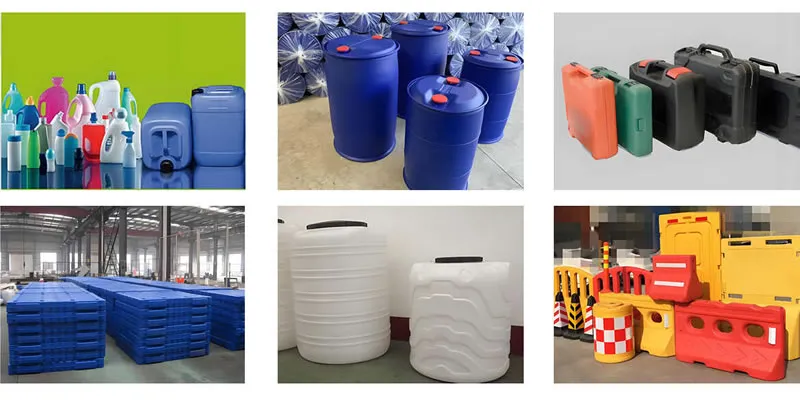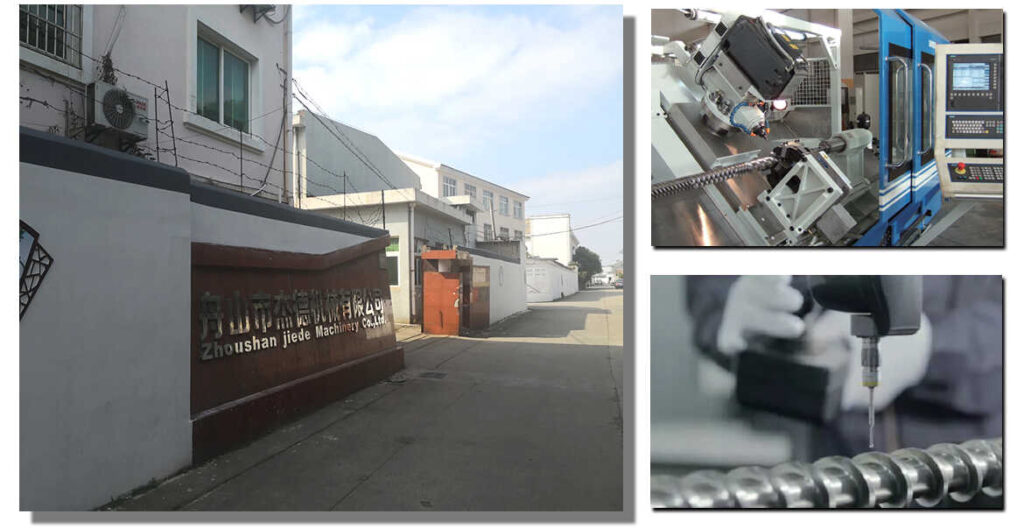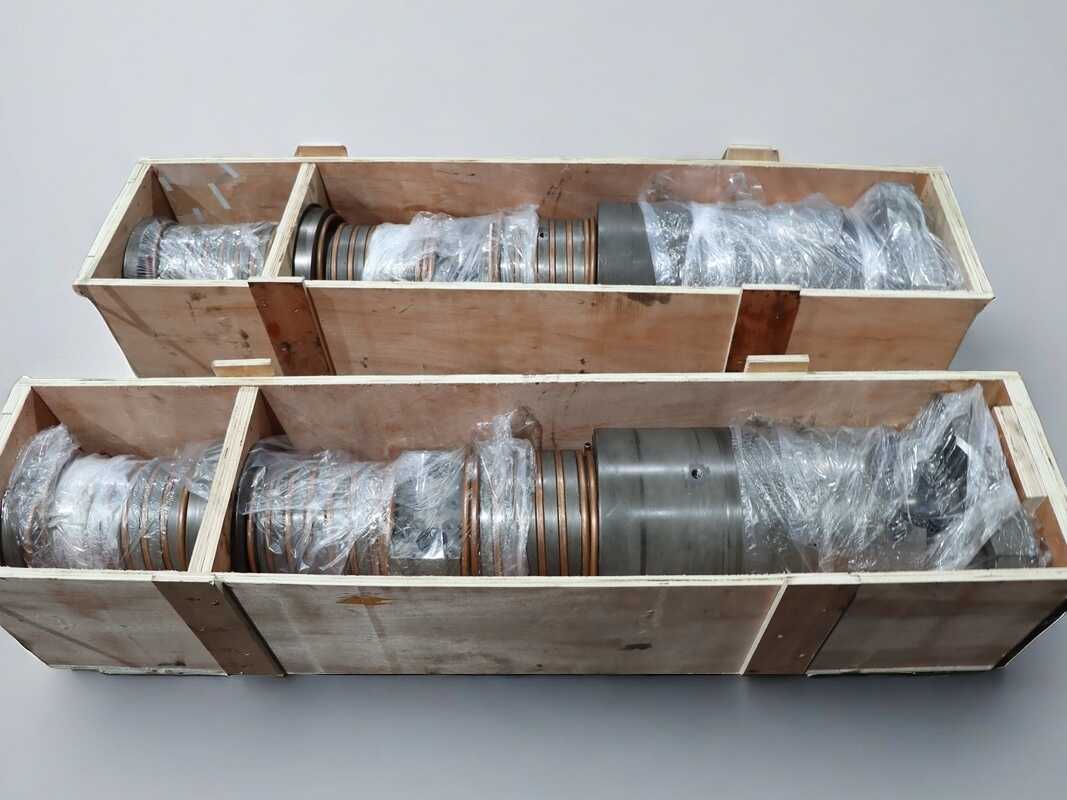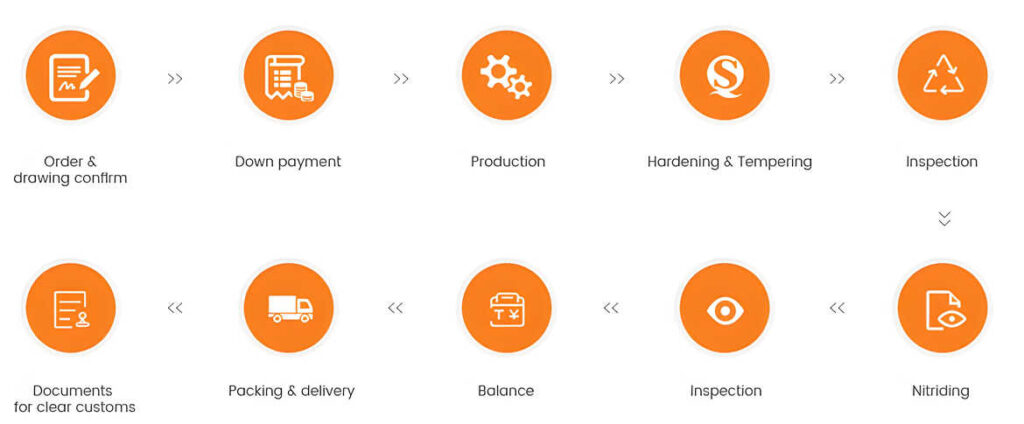The blow molding screw is a core component of plastic blow molding equipment, primarily used for plasticizing, melting, and conveying plastic raw materials. The following is comprehensive information about blow molding screws:
I. Main Types and Features
Conventional Screws
Separable Screws
Barrier Screws
New Screws
Split-Flow Screws: Adding pins or splitter blocks improves mixing.
โครงสร้างสกรูเหมาะสำหรับ
PE, PP, ABS, PET, PETG, PA ฯลฯ
ใช้ได้กับเครื่องเป่าขึ้นรูปชิ้นส่วนรูปทรงพิเศษรุ่นต่อไปนี้:
พนักพิงเก้าอี้ ฐาน พาเลท ถังน้ำรถ กล่องเครื่องมือ ฯลฯ
เครื่องซ้อนถังยูเรียและสารเคมี
เครื่องเป่าขวดล้างสารเคมีรายวัน
เครื่องเป่าขวดอาหารและเครื่องดื่ม
เครื่องเป่าขึ้นรูปสำหรับสิ่งอำนวยความสะดวกบนทางหลวง
ขั้นตอนการติดตั้งและข้อควรระวังสำหรับกระบอกสกรูเครื่องขึ้นรูปเป่า
การติดตั้งสกรูกระบอก
ก่อนการติดตั้ง ควรติดตั้งสกรูสำรองไว้กับตัวกระบอกก่อน เพื่อป้องกันไม่ให้สกรูเลื่อนเข้าไปในตัวกระบอก อย่าถอดสายไฟที่ยึดแน่นออกก่อน เพื่อความปลอดภัย ให้ยึดไม้ชิ้นเล็กๆ ไว้ตรงกลางช่องป้อน จากนั้นยกไม้ขึ้นวางในตำแหน่งเดิมของกระบอก ยึดให้แน่น แล้วเชื่อมต่อหัวเก็บและส่วนป้อน
หลังจากติดตั้งถังแล้ว ให้ยกตัวลดเกียร์กลับเข้าที่โครงของเครื่องเป่าพลาสติก ก่อนการติดตั้ง ให้ทาจาระบีเล็กน้อยที่ปลอกต่อเพลาหลักของตัวลดเกียร์และที่ด้ามจับสกรู เพื่อป้องกันสนิมและช่วยให้ถอดประกอบได้ง่ายขึ้นในครั้งต่อไป การติดตั้งชิ้นส่วนนี้จำเป็นต้องใช้เครื่องมือถอดสกรูแบบพิเศษ ด้ามจับสกรูของบริษัทเรามีรูสำหรับติดตั้งสกรู เมื่อติดตั้ง ให้ใส่สกรูเข้าไปในรูด้านในของเพลาหลักของตัวลดเกียร์ ขันสกรูเข้าไปในรูสกรูสำหรับติดตั้งสกรู จากนั้นจัดตำแหน่งลิ่มของตัวลดเกียร์และสกรูให้ตรงกัน จากนั้นใส่สกรูผ่านน็อตและดึงเข้าไปในตัวลดเกียร์
หลังจากเสร็จสิ้นขั้นตอนก่อนหน้าแล้ว ขั้นตอนต่อไปคือการเชื่อมต่อชิ้นส่วนต่างๆ เข้าด้วยกัน ขั้นแรก ให้ยึดสลักเกลียวของอุปกรณ์เครื่องเป่าพลาสติกและตัวลดขนาด ติดตั้งและยึดสลักเกลียวของตัวลดขนาดและส่วนป้อน เชื่อมต่อข้อต่อและมอเตอร์อัดรีด และติดตั้งเครื่องทำความร้อนและสายไฟ ขั้นตอนนี้ต้องมั่นใจว่าการติดตั้งและการเชื่อมต่อของแต่ละชิ้นส่วนถูกต้อง
ขั้นตอนต่อไปคือการติดตั้งอุปกรณ์ป้อนวัตถุดิบ ขั้นแรก ตรวจสอบการเชื่อมต่อของสายไฟ สลักเกลียว และอุปกรณ์เครื่องเป่าขึ้นรูปแต่ละชิ้น จากนั้นให้ความร้อนกับเครื่องเพื่อทดสอบ
เมื่อทำการตรวจสอบและซ่อมแซมมอเตอร์อัดรีด สามารถเปลี่ยนจารบีของตัวลดรอบได้
ข้อควรระวังในการใช้สกรูกระบอก
พลาสติกแต่ละชนิดมีช่วงอุณหภูมิที่เหมาะสมในการขึ้นรูปพลาสติก จึงควรควบคุมอุณหภูมิของถังให้ใกล้เคียงกับช่วงอุณหภูมินี้ เม็ดพลาสติกจะเข้าสู่ถังจากช่องป้อนและเข้าสู่ส่วนป้อนก่อน แรงเสียดทานแห้งจะเกิดขึ้นในส่วนป้อนอย่างหลีกเลี่ยงไม่ได้ เมื่อพลาสติกเหล่านี้ไม่ได้รับความร้อนเพียงพอและหลอมละลายไม่สม่ำเสมอ อาจทำให้ผนังด้านในของถังและพื้นผิวของสกรูสึกหรอมากขึ้น เช่นเดียวกัน ในส่วนการบีบอัดและส่วนการทำให้เป็นเนื้อเดียวกัน หากพลาสติกหลอมเหลวไม่เป็นระเบียบและไม่สม่ำเสมอ ก็จะทำให้เกิดการสึกหรอมากขึ้นเช่นกัน ห้ามหมุนสกรูเมื่ออุณหภูมิไม่เพียงพอ
ควรปรับความเร็วให้เหมาะสม เนื่องจากพลาสติกบางชนิดมีการเติมสารเสริมแรง เช่น ใยแก้ว แร่ธาตุ หรือสารตัวเติมอื่นๆ แรงเสียดทานของสารเหล่านี้กับวัสดุโลหะมักจะสูงกว่าแรงเสียดทานของพลาสติกหลอมเหลวมาก เมื่ออัดพลาสติกเหล่านี้ หากใช้ความเร็วสูง ขณะเดียวกันก็เพิ่มแรงเฉือนบนพลาสติก การเสริมแรงจะทำให้เกิดเส้นใยฉีกขาดมากขึ้นตามไปด้วย เส้นใยฉีกขาดมีปลายแหลมคม ซึ่งจะเพิ่มแรงสึกหรออย่างมาก เมื่อแร่ธาตุอนินทรีย์เลื่อนบนพื้นผิวโลหะด้วยความเร็วสูง ผลกระทบจากการขูดขีดก็จะไม่น้อยเช่นกัน ดังนั้นจึงไม่ควรปรับความเร็วให้สูงเกินไป
กำจัดเศษวัสดุออกจากพลาสติก โดยทั่วไปแล้วพลาสติกใหม่ที่ซื้อมาในบรรจุภัณฑ์เดิมจะไม่มีเศษวัสดุ แต่หลังจากการขนส่ง การชั่งน้ำหนัก การอบแห้ง การผสมสี และโดยเฉพาะอย่างยิ่งการเติมวัสดุรีไซเคิล อาจมีเศษวัสดุปะปนอยู่ด้วย เศษโลหะขนาดเล็ก ขดลวดทำความร้อนขนาดใหญ่ น็อต คลิปหนีบกระดาษ สลักเกลียว ฯลฯ ปะปนอยู่ในกระบอก ความเสียหายของสกรูนั้นเห็นได้ชัด (แน่นอนว่ากระบอกก็เสียหายไปพร้อมกัน) และแม้แต่สกรูก็ยังติดอยู่ เมื่อเกิดแรงบิดสูง สกรูจะหักและขอบด้านบนของกระบอกจะเสียรูป ดังนั้นจึงจำเป็นต้องมีการจัดการและควบคุมการป้อนอย่างเคร่งครัด
ความชื้นที่มีอยู่ในพลาสติกมีผลต่อการสึกหรอของพื้นผิวสกรู หากพลาสติกมีความชื้นค่อนข้างมาก ความชื้นจะไม่ถูกกำจัดออกจนหมดก่อนการอัดขึ้นรูป เมื่อความชื้นตกค้างเข้าสู่ส่วนอัดของสกรู จะเกิด “อนุภาคไอน้ำ” ที่มีอุณหภูมิและความดันสูง ซึ่งจะถูกหลอมละลายและผสมเข้ากับพลาสติกที่หลอมเหลวก่อนหน้านี้ เมื่อสกรูเคลื่อนที่จากส่วนการทำให้เป็นเนื้อเดียวกันไปยังหัวสกรูในกระบวนการอัดขึ้นรูป “อนุภาคไอน้ำ” เหล่านี้จะถูกคลายการบีบอัดและขยายตัวในระหว่างกระบวนการอัดขึ้นรูป คล้ายกับอนุภาคสิ่งเจือปนขนาดเล็ก ซึ่งมีผลเสียต่อการเสียดสีและการทำลายพื้นผิวผนัง อีกทั้งยังส่งผลกระทบอย่างมากต่อคุณภาพของผลิตภัณฑ์ที่อัดขึ้นรูป และอาจทำให้เกิดการป้อนที่ไม่เสถียร








